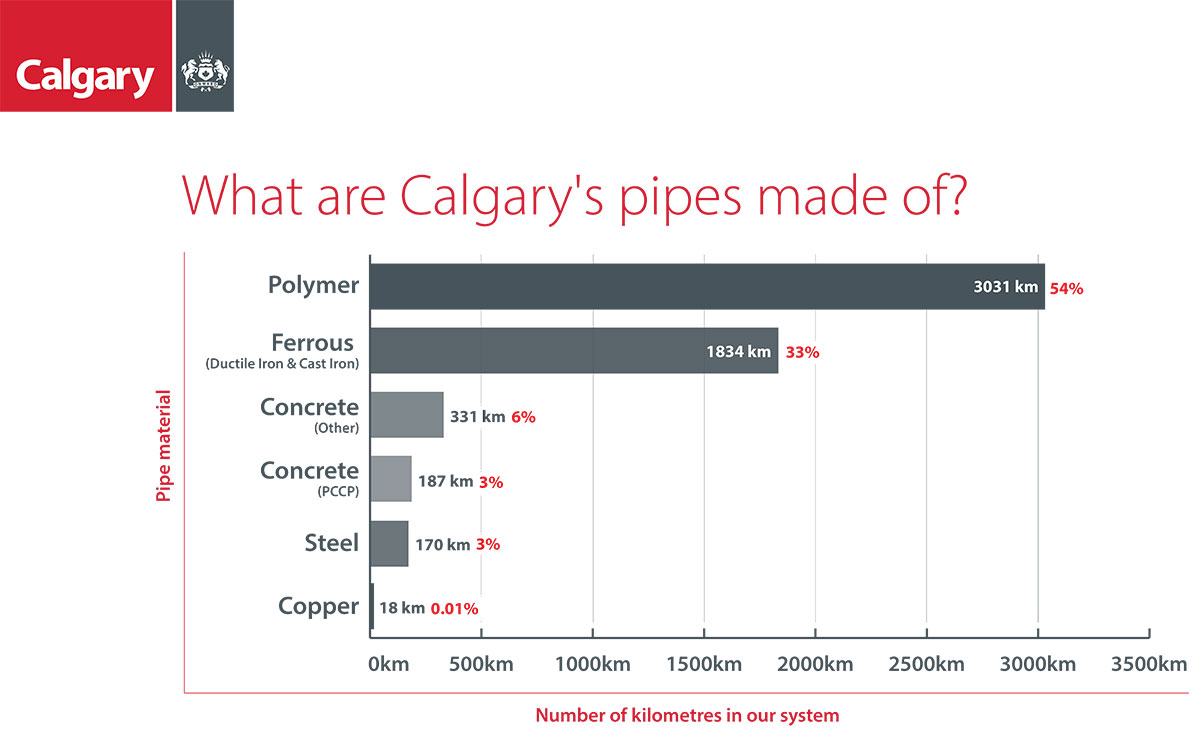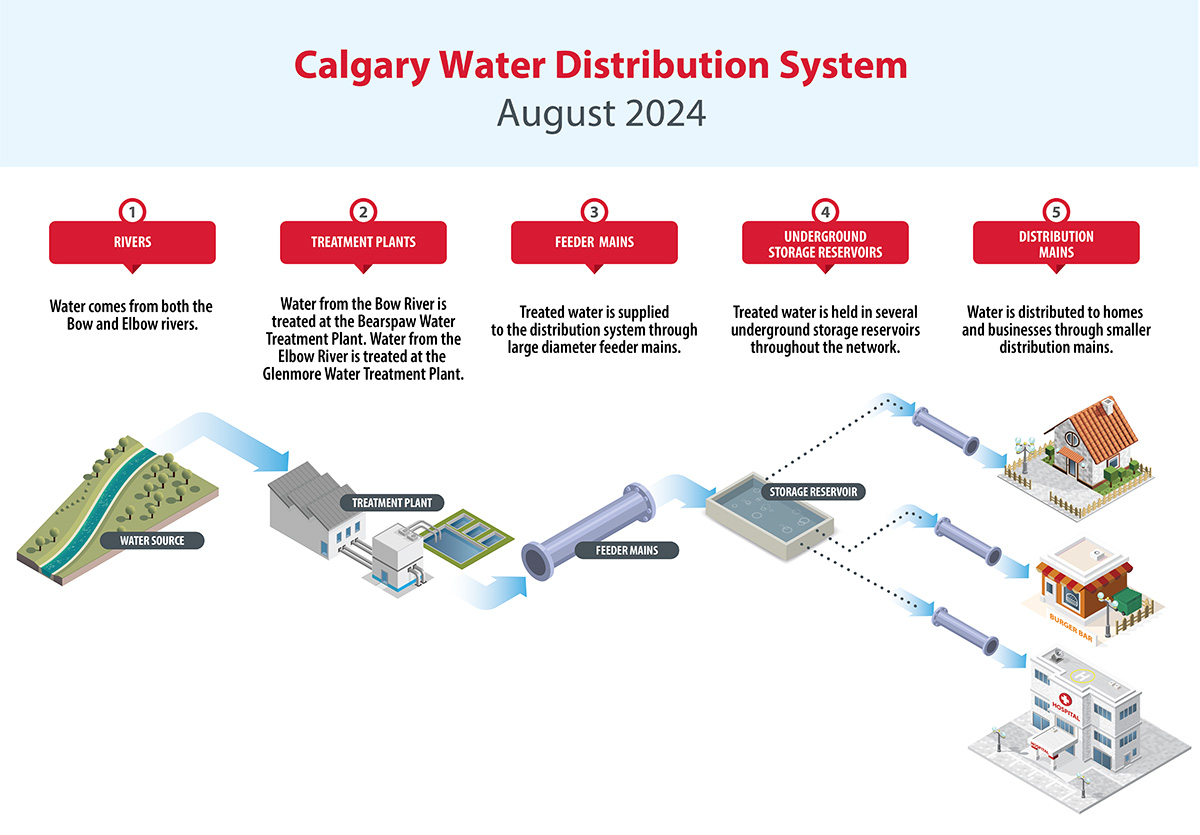Bearspaw South Feeder Main - Frequently asked questions (FAQs)
The City of Calgary experienced a catastrophic break on the Bearspaw South Feeder Main on June 5, 2024. This feeder main is the largest in Calgary’s network, and distributes a significant portion of the city’s treated water supply. This break was repaired in June 2024, along with five additional “hot spots” that were discovered.
In August/September 2024, additional repair work was carried out on 21 segments along the feeder main.
Beginning October 16, 2024, three additional segments of the Bearspaw South Feeder Main will be repaired. No water restrictions will be required for this next phase of work.
On this page
October/November repair work
When will these repairs be taking place?
Preparation work is expected to begin on October 16, with major work beginning the week of October 21. Work is expected to be completed around November 21. Please note these timelines are subject to change.
Will there be water restrictions while this work is taking place?
No. These repairs won’t require city-wide water restrictions because these sections of the feeder main can be isolated while keeping the feeder main running.
What are the locations of this repair work?
While our teams are in the process of finalizing construction details and exact worksite locations, we can share some preliminary maps and information about the upcoming traffic and parking impacts to anticipate. For more information on repair work locations and associated closures and detours, please visit the construction page.
What method is being used for these repair areas?
The weakened areas of the pipe will be removed and replaced. This approach is similar to the one that was taken in June to repair the initial feeder main break.
Will residents and businesses be affected?
Some residents and businesses may be affected by construction work in the immediate area. Affected homes and businesses will be contacted directly by the City of Calgary. All businesses and residential access will remain open, but increased traffic congestion will be expected while work is taking place. Efforts will be made to minimize local disruptions as much as possible.
Will there be pathway closures associated with this work?
Yes, some pathway closures will be necessary. Visit the pathway closures page for more information.
Is work going to take place 24/7?
Work is anticipated to take place from 6:30 a.m. to 10:00 p.m., 7 days a week.
Top questions
Is there anything residents need to do now that water has been restored?
Some customers may notice that their water appears cloudy. This will resolve itself over time. If the issue persists, please contact 311.
You may also experience a strong chlorine smell for a short period now that the feeder main has returned to service. Chlorine levels were increased during the filling of the feeder main to disinfect it. Your water remains safe for consumption.
Will there be more work required on the Bearspaw South Feeder Main?
Additional repairs will take place in October/November of this year along the Bow River Pathway near 26 St N.W. and Parkdale Blvd N.W.
This next phase includes two excavation sites with two segments of pipe that need to be repaired. We do not anticipate phase two to be as significant as what Calgarians will be experiencing during phase one of the repairs.
These repairs will not require the shutdown of the feeder main so water restrictions during this phase are not expected.
Is The City gathering more data about the condition of the Bearspaw South Feeder Main?
We have engaged consultants to provide a detailed forensics report. This will include fulsome results from the PipeDiver, and soil and structural analysis of the pipe.
Once we have received the final version, we will be able to provide more details on the findings and next steps. The findings of the report will be shared at the December Infrastructure and Planning Committee Meeting
What are the City’s medium to long term plans for this feeder main and the rest of the water distribution network ?
Planning is underway to ensure our water distribution infrastructure is reliable and resilient. These medium and long-term plans are still being developed using a combination of data from the PipeDiver device, electromagnetic testing, and visual inspections when the pipe is excavated.
Regarding the existing Bearspaw South Feeder Main, we are considering various options including:
- Replacing individual segments of pipe;
- Externally reinforcing segments of pipe;
- Lining the existing pipe, or
- Installing a new pipe nearby.
Work continues on these plans, and we will share more information when it is available.
Outside of the rehabilitation work on the Bearspaw South Feeder Main, we are also working on plans to increase redundancy in our water distribution system. This includes developing a new North Feeder Main and South Feeder Main. We are currently in the design phase of the North Calgary Water Servicing Project and plan to start construction next year. Both projects will be delivered in phases over eight years.
Redundancy is an important next step in the long-term rehabilitation of the feeder main as it will allow us to take the existing feeder main out of service while limiting the impacts to Calgarians and our customers. It also ensures we continue to provide clean, safe drinking water to Calgarians while meeting the demands of our growing city.
What is the total cost of the repairs to date?
The cost of the original emergency repair work in June 2024, which included the initial break and five hot spots, has been estimated to be between $20 and $25 million. This cost estimate does not include any lost revenue for City services associated with the break and the repairs.
We were able to better manage the cost of the August/September 2024 repairs, although much bigger in scope than the work we completed in June, because they were planned rather than an emergency.
The cost of the 21 repairs completed in August/September was approximately $15.5 million.
Calgary’s water supply and distribution network
Where does Calgary’s water come from?
Calgary gets its water from two water treatment plants: the Glenmore Water Treatment Plant, on the Elbow River, and the Bearspaw Water Treatment Plant, on the Bow River.
The Bearspaw South Feeder Main, which distributes treated water from the Bearspaw Water Treatment Plant, is the largest feeder main in our network.
How does water flow from the treatment plant to homes and businesses?
Water is drawn from the rivers and is treated at either the Glenmore or Bearspaw Water Treatment Plant.
After it’s treated and is safe to drink, water moves through large pipes called feeder mains to underground storage reservoirs. (Unlike the Glenmore Reservoir, which stores untreated river water, these underground storage reservoirs contain treated water).
From there, water flows through smaller distribution mains to homes and businesses.
What are Calgary’s pipes made of?
Several different materials are used:

What is a pre-stressed concrete cylindrical pipe (PCCP)?
Pre-stressed concrete cylindrical pipes, such as the Bearspaw South Feeder Main, have a composite construction made up of a steel reinforcement cable sandwiched between layers of concrete.
The City said many water pipes were originally installed around 1975. When are they due to be replaced?
These pipes can last a long time, as much as 100 years in ideal conditions. 98% of Calgary’s feeder mains, which are critical pipes in our distribution system, are in good or very good condition. This is aligned with the target we have set for our system.
Given the importance of the Bearspaw South Feeder Main to the operations of the water system, why did The City not do more to safeguard against a failure?
While the risk of a pipe break was deemed lower based on available data and modeling, The City did take action to reduce the impact of a failure. Investments in replacement air valves reduced risk factors to operations.
The City has also invested in the reliability of the two water treatment plants and the broader pipe network to improve the capacity of the system to deliver water even when a failure occurs.
The 2011 and 2021 Water Long Range Plans also included future investments that will improve the redundancy of the system. An Emergency Response Plan for the Bearspaw South Feeder Main was prepared to quickly respond to a failure and maintain service while a repair was executed. This plan also included our critical parts inventory.
When was the pipe last inspected? How is a water main inspected?
The most recent maintenance work happened in the spring of 2024, including replacement of air valves and the installation of an acoustic monitoring device. Routine field checks on valve chambers are also performed regularly.
Several test shutdowns were undertaken in the winter of 2023 and spring 2024 in preparation for a full condition assessment planned for December 2024.
98% of our water distribution system is rated as being in “good” or “very good” physical condition. This rating is due to The City’s ongoing condition assessment and maintenance programs, which help to identify and address potential problems.
We are unable to physically inspect all existing infrastructure every year, so physical condition is based on a combination of asset characteristics, physical observations, operational knowledge, and experience of known issues.
How does The City monitor the condition of the pipe without completing an inspection?
The City has an annual inspection program for its pipe assets, including feeder mains. The logistics of inspecting over 5,000 km of pipe means that inspection data is supplemented with modeling of pipe condition. Inspection data are used to calibrate this model, which also incorporates factors of pipe material, pipe age, known condition, failure history, location, operating pressures, soil parameters and cathodic protection.
The model, along with an evaluation the assets hydraulic importance in the system, ease of repair, and by understanding the social, environmental, and financial consequences of potential failures, is used to guide inspection efforts and identify candidates for the pipe replacement program. Pipe breaks are used to continually improve the modeling results.
I understand The City uses something called acoustic monitoring. What is this and how does it work?
There are two types of acoustic monitoring available for this type of pipe. External acoustic monitors are discreet sensors mounted to the outside of the pipe. They pickup events within the pipe (possible wire breaks) but are low-resolution compared to the fiber optic monitoring. They can tell us if an event occurred near a sensor, but they cannot tell us which pipe section has experienced the event.
The second type of acoustic monitoring is fiber optic acoustic monitoring. Fibre optic cable is installed inside the pipe and is connected to a data acquisition system which can accurately identify the location of an event. Along with the baseline condition, data collected from the electromagnetic inspection can continuously monitor the condition of the pipeline so we can take appropriate action when the wire break count exceeds a threshold.


